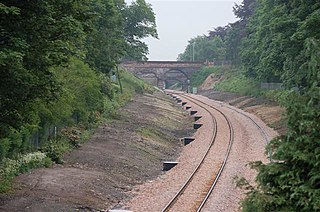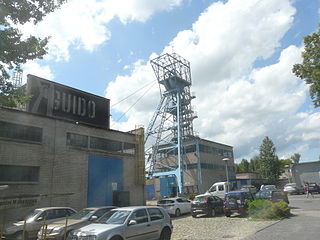
The Firth of Forth is the estuary (firth) of several Scottish rivers including the River Forth. It meets the North Sea with Fife on the north coast and Lothian on the south.

Longannet power station was a large coal-fired power station in Fife, and the last coal-fired power station in Scotland. It was capable of co-firing biomass, natural gas and sludge. The station stood on the north bank of the Firth of Forth, near Kincardine on Forth.
The Upper Hirst is a coal seam in central Scotland that was mined in the 1950s through to 2002, mainly to supply Kincardine Power Station, and later, Longannet Power Station, in Fife.

Valleyfield consists of High Valleyfield and Low Valleyfield which are neighbouring villages in Fife, Scotland, midway between Dunfermline and Kincardine-on-Forth. Low Valleyfield is on the shore of the Firth of Forth, High Valleyfield on the ridge immediately to the north.

The Stirling–Alloa–Kincardine rail link is a completed railway project to re-open 21 kilometres (13 mi) of between Stirling, Alloa and Kincardine in Scotland. The route opened to rail traffic in March 2008.
The Kincardine Line is a railway in Clackmannanshire and Fife, Scotland. It was originally built to serve settlements along the north shore of the Firth of Forth, between Alloa and Dunfermline.

The Eglinton Castle estate was situated at Irvine, on the outskirts of Kilwinning, North Ayrshire, Scotland in the former district of Cunninghame. Eglinton Castle, was once home to the Montgomeries, Earls of Eglinton and chiefs of the Clan Montgomery. Eglinton Country Park now occupies part of the site.
Preston Island is a former artificial island in the Firth of Forth, Scotland. The reclaimed land was once used for salt production, using local coal. It is part of Fife.
Open-pit coal mining in the United Kingdom is in decline. Output has fallen every year since 2010. In 2010, the United Kingdom was forecast to produce about ten million tonnes of coal a year from open-pit mines. Most came from Scotland, with the largest operator there being the Scottish Coal subsidiary of Scottish Resources Group. Actual production in 2010 was over 13 million tonnes but this has declined to less than 8 million tonnes in 2014. Deep coal mining stopped completely at the end of 2015 and the UK is planning to phase out the use of coal to produce electricity by 2024.

The Fife Coalfield was one of the principal coalfields in Scotland. Over fifty collieries were in operation at various times between the middle of the nineteenth century and the closure of the last pit in 1988. The coalfield extended across the southern part of Fife where rocks of the Coal Measures Group occur and was one of a series of coalfields throughout the Midland Valley from which coal was won by both deep workings and opencasting methods. It is traditionally divided into the West Fife, Central Fife and East Fife coalfields with Kirkcaldy having been a particularly important area. Some of the mines extended beyond Fife under the Firth of Forth following the seams which occupy the Leven Syncline which extends to the south shore of the firth at Musselburgh and beyond.

The Midlothian Coalfield is a coalfield in southeast Scotland situated immediately to the east and southeast of Edinburgh. It is geologically continuous with the East Fife Coalfield beneath the Firth of Forth though the undersea coal reserves have only been partly exploited. There were undersea workings extending from Prestonlinks Colliery. The sulphur content of the majority of Midlothian coals is less than 1% making it especially suitable for modern requirements.
Raniganj Coalfield is primarily located in the Asansol and Durgapur subdivisions of Paschim Bardhaman district of West Bengal. It spreads over to the neighboring districts of Birbhum, Bankura, Purulia and to Dhanbad district of Jharkhand.
The Tarenni Colliery and its associated workings, are a series of coal mines and pits located between the villages of Godre'r Graig and Cilybebyll located in the valley of the River Tawe, in Neath Port Talbot county borough, South Wales.
The Firth of Forth was historically crossed by ferry until the opening of the Forth Road Bridge in 1964.

The Guido mine, Polish: Zabytkowa Kopalnia Węgla Kamiennego is a historic deep coal mine and museum in Zabrze, Silesia, Poland. The museum is an Anchor point on the European Route of Industrial Heritage. This is an object of cultural heritage inscribed in the registry of the Silesian Voivodeship and a cultural monument in Poland.
The Diglake Colliery Disaster, was a coal-mining disaster at what was Audley Colliery in Bignall End, North Staffordshire, on 14 January 1895. A flood of water rushed into the mine and caused the deaths of 77 miners. Only three bodies were recovered, with efforts to retrieve the dead hampered by floodwater. 73 bodies are still entombed underground.
Bokaro and Kargali Area is one of the operational areas of the Central Coalfields Limited located mainly in the Bokaro district and partly in the Giridih district, both in the state of Jharkhand, India.
Hazaribagh Area is one of the operational areas of the Central Coalfields Limited located mainly in the Hazaribagh and Ramgarh districts in the state of Jharkhand, India.
Kuju Area is one of the operational areas of the Central Coalfields Limited located mainly in the Ramgarh district in the state of Jharkhand, India.
Argada Area is one of the operational areas of the Central Coalfields Limited located in the Ramgarh and Hazaribagh districts in the state of Jharkhand, India.